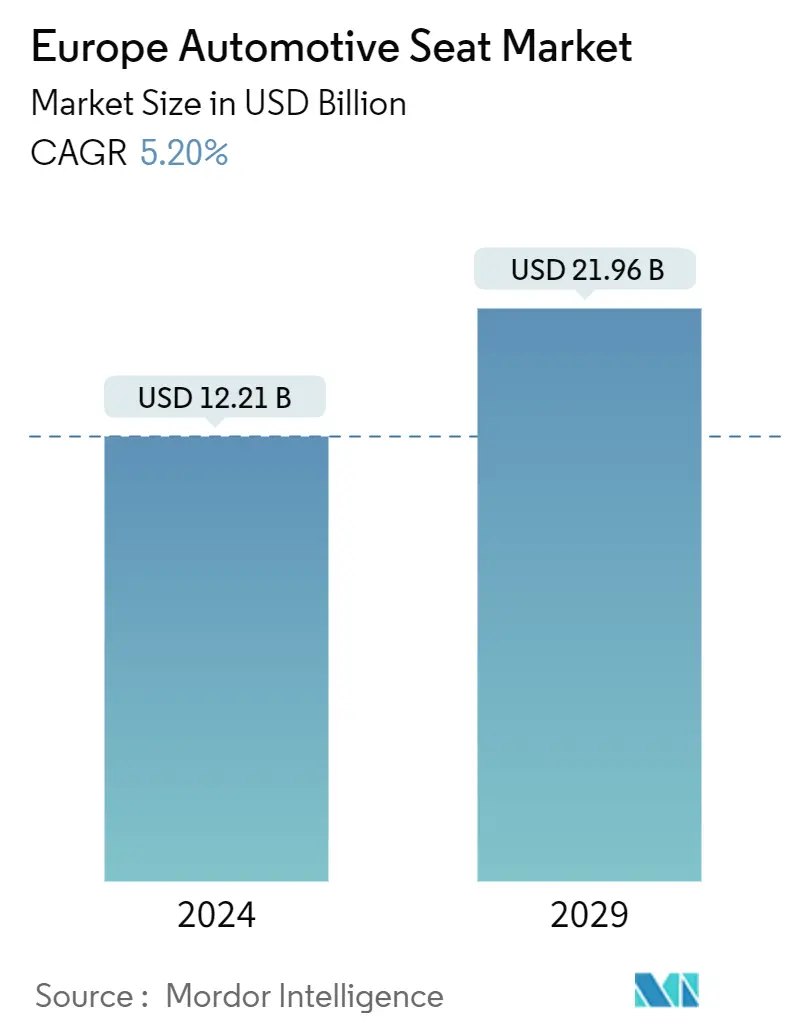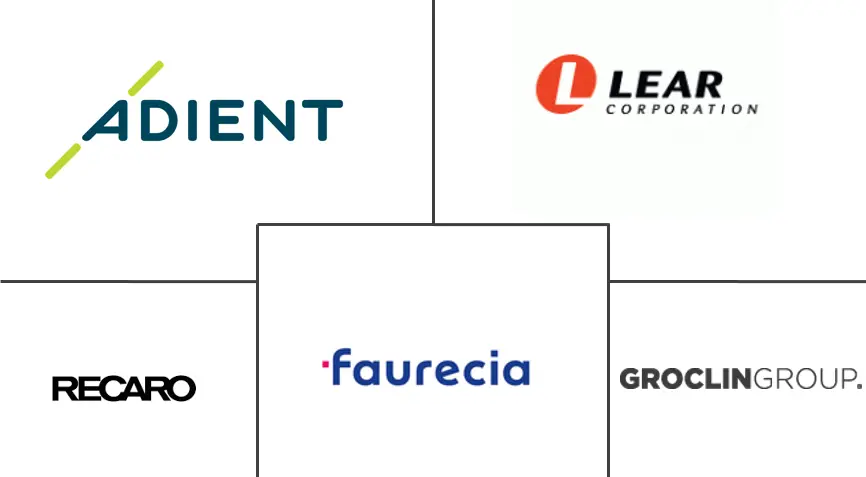Market Size of Europe Automotive Seat Industry

| Study Period | 2019 - 2029 |
| Base Year For Estimation | 2023 |
| Market Size (2024) | USD 12.21 Billion |
| Market Size (2029) | USD 21.96 Billion |
| CAGR (2024 - 2029) | 5.20 % |
| Market Concentration | High |
Major Players
*Disclaimer: Major Players sorted in no particular order |
Europe Automotive Seat Market Analysis
The Europe Automotive Seat Market size is estimated at USD 12.21 billion in 2024, and is expected to reach USD 21.96 billion by 2029, growing at a CAGR of 5.20% during the forecast period (2024-2029).
Over the long term, the rising vehicle sales are expected to boost automotive seat production to meet the increasing demand. Increasing passenger comfort has become one of the most important considerations in the passenger car market, and seats are significant in this aspect.
Consumer demand for safety and comfort in automobiles is a vital factor driving the changes in the manufacturing of automotive seats. Luxurious, comfortable, and safe automotive seating systems are gaining preference among consumers, which, in turn, is prompting OEMs to seek automotive seats that could satisfy consumer expectations. Further, growing concerns about the use of plastic and plastic disposal are causing automotive seat manufacturers to invest heavily in the research and development of new materials for manufacturing automotive seats.
The powered seat and ventilated seat segments are expected to record a high growth rate because of the rising sales of luxury vehicles and the increasing adoption of such seats in mid-segment cars. Ventilated seats help in temperature regulation, which helps in reducing energy emissions through air conditioners, sunroofs, etc. Increased awareness about the intelligent seating solutions offered by manufacturers has enhanced the perceived quality. For instance,
In January 2023, Fauresia SE introduced automotive seat design and manufacturing, which will help to reduce the number of components used in a standard seat from around 120 to 10 modules. The modules are easily assembled and disassembled, allowing the seat's components (such as the cover and cushions) to be replaced and new functions (such as massages, lumbar support, and so on) to be added over time.
Over the years, the demand for lightweight seats has been rising. With concerns about fuel efficiency, the seats are focused on cutting down weight to aid the performance of vehicles. Additionally, sustainability is gradually becoming a key factor influencing consumer decisions. This pervasive trend is estimated to boost the demand for lightweight automotive seats to produce fuel-efficient and high-performance vehicles.
Europe Automotive Seat Industry Segmentation
A seat belt is a vehicle safety device meant to protect the driver and occupants of a vehicle from extreme movement caused by a collision or sudden halt. A seat belt reduces the likelihood of death or serious injury during a crash by reducing the force of subsequent impacts with interior striking risks.
The European automotive seat market is segmented by material (leather, fabric, and other materials), technology (standard seats, powered seats, ventilated seats, child safety seats, and other seats), vehicle type (passenger car and commercial vehicle), Sales channel (OEM and aftermarket), and geography (Germany, United Kingdom, Italy, France, Netherlands, Spain, and Rest of Europe).
The report offers the market sizes and forecasts in value (USD) for all the above segments.
| By Material | |
| Leather | |
| Fabric | |
| Other Materials |
| By Technology | |
| Standard Seats | |
| Powered Seats | |
| Ventilated Seats | |
| Child Safety Seats | |
| Other Seats |
| By Vehicle Type | |
| Passenger Car | |
| Commercial Vehicle |
| Sales Channel | |
| OEM | |
| Aftermarket |
| Geography | |
| Germany | |
| United Kingdom | |
| Italy | |
| France | |
| Netherlands | |
| Spain | |
| Rest of Europe |
Europe Automotive Seat Market Size Summary
The European automotive seat market is poised for significant growth, driven by increasing vehicle sales and a rising demand for enhanced passenger comfort and safety. As consumers prioritize luxurious and comfortable seating solutions, original equipment manufacturers (OEMs) are compelled to innovate and invest in advanced automotive seat technologies. This trend is further fueled by growing environmental concerns, prompting manufacturers to explore sustainable materials and lightweight designs to improve fuel efficiency. The market is witnessing a surge in demand for powered and ventilated seats, particularly in luxury and mid-segment vehicles, as these features offer added comfort and energy efficiency. The aftermarket segment is also expanding, with consumers seeking customizable and ergonomic seating options to enhance their driving experience.
Germany leads the European automotive seat market, supported by its robust automotive industry and advanced manufacturing capabilities. The country's dominance is reflected in its significant production and export of automotive seats, followed by the United Kingdom and the Czech Republic. The market is further bolstered by the growing production of electric vehicles, with countries like the Netherlands and Norway at the forefront of this trend. Major players in the market, such as Adient PLC and Faurecia, are investing heavily in research and development to stay competitive and meet the evolving consumer demands. The market's consolidation is evident as a few key players continue to drive innovation and expand their presence across the region, leveraging advancements in technology and sustainable practices to capture a larger market share.
Europe Automotive Seat Market Size - Table of Contents
-
1. MARKET DYNAMICS
-
1.1 Market Drivers
-
1.1.1 Increasing Demand for Aftermarket Upholstery Modifications May Drive the Market
-
-
1.2 Market Restraints
-
1.2.1 Fluctuation in Raw Material Prices
-
-
1.3 Industry Attractiveness - Porter's Five Forces Analysis
-
1.3.1 Threat of New Entrants
-
1.3.2 Bargaining Power of Buyers/Consumers
-
1.3.3 Bargaining Power of Suppliers
-
1.3.4 Threat of Substitute Products
-
1.3.5 Intensity of Competitive Rivalry
-
-
-
2. MARKET SEGMENTATION (Value in USD)
-
2.1 By Material
-
2.1.1 Leather
-
2.1.2 Fabric
-
2.1.3 Other Materials
-
-
2.2 By Technology
-
2.2.1 Standard Seats
-
2.2.2 Powered Seats
-
2.2.3 Ventilated Seats
-
2.2.4 Child Safety Seats
-
2.2.5 Other Seats
-
-
2.3 By Vehicle Type
-
2.3.1 Passenger Car
-
2.3.2 Commercial Vehicle
-
-
2.4 Sales Channel
-
2.4.1 OEM
-
2.4.2 Aftermarket
-
-
2.5 Geography
-
2.5.1 Germany
-
2.5.2 United Kingdom
-
2.5.3 Italy
-
2.5.4 France
-
2.5.5 Netherlands
-
2.5.6 Spain
-
2.5.7 Rest of Europe
-
-
Europe Automotive Seat Market Size FAQs
How big is the Europe Automotive Seat Market?
The Europe Automotive Seat Market size is expected to reach USD 12.21 billion in 2024 and grow at a CAGR of 5.20% to reach USD 21.96 billion by 2029.
What is the current Europe Automotive Seat Market size?
In 2024, the Europe Automotive Seat Market size is expected to reach USD 12.21 billion.

